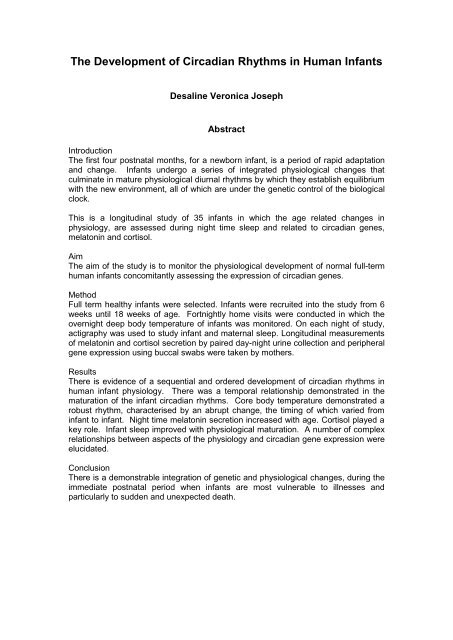The Development of Circadian Rhythms in Human Infants
The Development of Circadian Rhythms in Human Infants
The Development of Circadian Rhythms in Human Infants
Create successful ePaper yourself
Turn your PDF publications into a flip-book with our unique Google optimized e-Paper software.
<strong>The</strong> <strong>Development</strong> <strong>of</strong> <strong>Circadian</strong> <strong>Rhythms</strong> <strong>in</strong> <strong>Human</strong> <strong>Infants</strong><br />
Desal<strong>in</strong>e Veronica Joseph<br />
Abstract<br />
Introduction<br />
<strong>The</strong> first four postnatal months, for a newborn <strong>in</strong>fant, is a period <strong>of</strong> rapid adaptation<br />
and change. <strong>Infants</strong> undergo a series <strong>of</strong> <strong>in</strong>tegrated physiological changes that<br />
culm<strong>in</strong>ate <strong>in</strong> mature physiological diurnal rhythms by which they establish equilibrium<br />
with the new environment, all <strong>of</strong> which are under the genetic control <strong>of</strong> the biological<br />
clock.<br />
This is a longitud<strong>in</strong>al study <strong>of</strong> 35 <strong>in</strong>fants <strong>in</strong> which the age related changes <strong>in</strong><br />
physiology, are assessed dur<strong>in</strong>g night time sleep and related to circadian genes,<br />
melaton<strong>in</strong> and cortisol.<br />
Aim<br />
<strong>The</strong> aim <strong>of</strong> the study is to monitor the physiological development <strong>of</strong> normal full-term<br />
human <strong>in</strong>fants concomitantly assess<strong>in</strong>g the expression <strong>of</strong> circadian genes.<br />
Method<br />
Full term healthy <strong>in</strong>fants were selected. <strong>Infants</strong> were recruited <strong>in</strong>to the study from 6<br />
weeks until 18 weeks <strong>of</strong> age. Fortnightly home visits were conducted <strong>in</strong> which the<br />
overnight deep body temperature <strong>of</strong> <strong>in</strong>fants was monitored. On each night <strong>of</strong> study,<br />
actigraphy was used to study <strong>in</strong>fant and maternal sleep. Longitud<strong>in</strong>al measurements<br />
<strong>of</strong> melaton<strong>in</strong> and cortisol secretion by paired day-night ur<strong>in</strong>e collection and peripheral<br />
gene expression us<strong>in</strong>g buccal swabs were taken by mothers.<br />
Results<br />
<strong>The</strong>re is evidence <strong>of</strong> a sequential and ordered development <strong>of</strong> circadian rhythms <strong>in</strong><br />
human <strong>in</strong>fant physiology. <strong>The</strong>re was a temporal relationship demonstrated <strong>in</strong> the<br />
maturation <strong>of</strong> the <strong>in</strong>fant circadian rhythms. Core body temperature demonstrated a<br />
robust rhythm, characterised by an abrupt change, the tim<strong>in</strong>g <strong>of</strong> which varied from<br />
<strong>in</strong>fant to <strong>in</strong>fant. Night time melaton<strong>in</strong> secretion <strong>in</strong>creased with age. Cortisol played a<br />
key role. Infant sleep improved with physiological maturation. A number <strong>of</strong> complex<br />
relationships between aspects <strong>of</strong> the physiology and circadian gene expression were<br />
elucidated.<br />
Conclusion<br />
<strong>The</strong>re is a demonstrable <strong>in</strong>tegration <strong>of</strong> genetic and physiological changes, dur<strong>in</strong>g the<br />
immediate postnatal period when <strong>in</strong>fants are most vulnerable to illnesses and<br />
particularly to sudden and unexpected death.














